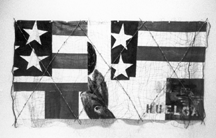

[ Metro | Metroactive Central | Archives ]
Barbed Borders Revolution's Banner: Part of Consuelo Underwood's 'Frontera Flag' series
Consuelo Underwood's art contrasts overt political messages with elegant technique
By Ann Elliott Sherman
Just like its title, resisTencia: unCertain hiStories, a six-year overview of Consuelo Jiménez Underwood's art, works on several different levels. Even a casual observer would be struck by the juxtaposition of Underwood's elegant and masterful weavings with her bluntly stated political pieces.
The Frontera Flag series exemplifies the latter. Each flag is a kind of crazy quilt of unevenly pieced elements from the banners of Mexico and the U.S.
Frontera Flag #2--Confrontation also features stamped Virgens de Guadalupe, UFW eagles and slogans of revolutionary struggle underneath three large, barbed-wire Xs crossing the surface. Underwood makes this ubiquitous metaphor for cross-cultural border issues say something new by wrapping the barbed wire in plastic, suggesting that all the supposed debate on the topic never gets down to the thornier realities. The flag is further veiled by a rough mesh of unevenly woven wire, a variation on Underwood's shorthand for the private stories behind her public expressions.
Frontera Flag #3--Solutions splices together vertical strips of the two nations' flags, mocking the "solution" of free trade by branding the broadest stripe with corporate logos that include companies infamous for their sweatshops.
Also in a political vein, Underwood's shrine to a vanquished land and its people, The Land Grabs 500 Tears, turns one wall of the gallery into a via dolorosa. Small, wooden hand looms display maps of the North, Central and South American land mass. The maps are penned on woven plastic strips interspersed with gold thread and framed by dun-colored textile borders.
The first map is left a blank outline; electric or metallic hues on successive maps diagram areas taken by conquest. The stations-of-the-cross effect is underscored by the simple wooden shelves below each map that hold votive candles, kernels of corn and broken bits of gold scavenged from computer parts, the last a shrewd bit of commentary on the continuing legacy of colonialism that lets no one off the hook.
Underwood achieves her most eloquent synthesis of craft and message with Buffalo Shroud. Natural silk is woven into a gridlike pattern that alternates delicately threaded, open areas with small blocks of tightly woven cloth, each stenciled with a tiny gold hoof print. The top border is stamped "1865-1878" and "60,000,000"; a smaller calico rectangle is embroidered "In Gold We Trust," with gilt thread on just the "L" highlighting the play on words.
The shroud tumbles onto the floor, finished with a few strips of blue calico and a loose fringe of single threads. This memorial to the slain natives of the plains is both elegy and history lesson. The narrative is driven as much by the materials and how they are used as by the terse obituary.
Underwood's skills as a weaver and her ability to integrate unconventional fibers into her pieces truly shine in her odes to the mysterious force of the moon. La Luna Negra alternates loosely woven bands, incorporating black chenille and plastic-coated wire with more tightly loomed panels and dividing them with borders of barbed wire. An overlay of black-linen net sparingly shot through with silver adds further texture and fascination. The work's quiet sheen, the feeling of being close enough to command attention yet not clearly seen in all its detail, creates an apt mimesis of our earthly encounters with the moon.
La Luna Blanca is similarly designed but in the more expected, shimmery tones of white laced with iridescent Mylar. It is the visual negative to its raven sister. The subtle inclusion of barbed wire in these pieces adds subtextual associations with the moon's influence on border crossings.
The technique exerts a gravitational pull on aesthetic delight that operates on the viewer's consciousness in the way that the astronomical phenomenon known as lunar libration allows more than the nearest surface of the moon to be seen.
The formal beauty of the shroud and the Lunas presents a distinct contrast with Underwood's flags and maps, a contrast, the artist allows, that is in itself a form of self-expression. "My homages to the elegance of nature command the best of my skills," she says. "It is a way of paying my respect to things I value. Flags and nations, as opposed to the land itself, don't really interest me that much. If they did, I'd have woven the cloth for the flags myself."
[ Metro | Metroactive Central | Archives ] This page was designed and created by the Boulevards team.

Christopher Gardner
resisTencia: unCertain hiStories runs through May 11 at MACLA/San José Center for Latino Arts, 510 S. First St. (408/998-ARTE). The artist will appear to discuss her work on April 11 at 7pm.
From the March 28-April 3, 1996 issue of Metro
Copyright © 1996 Metro Publishing and Virtual Valley, Inc.